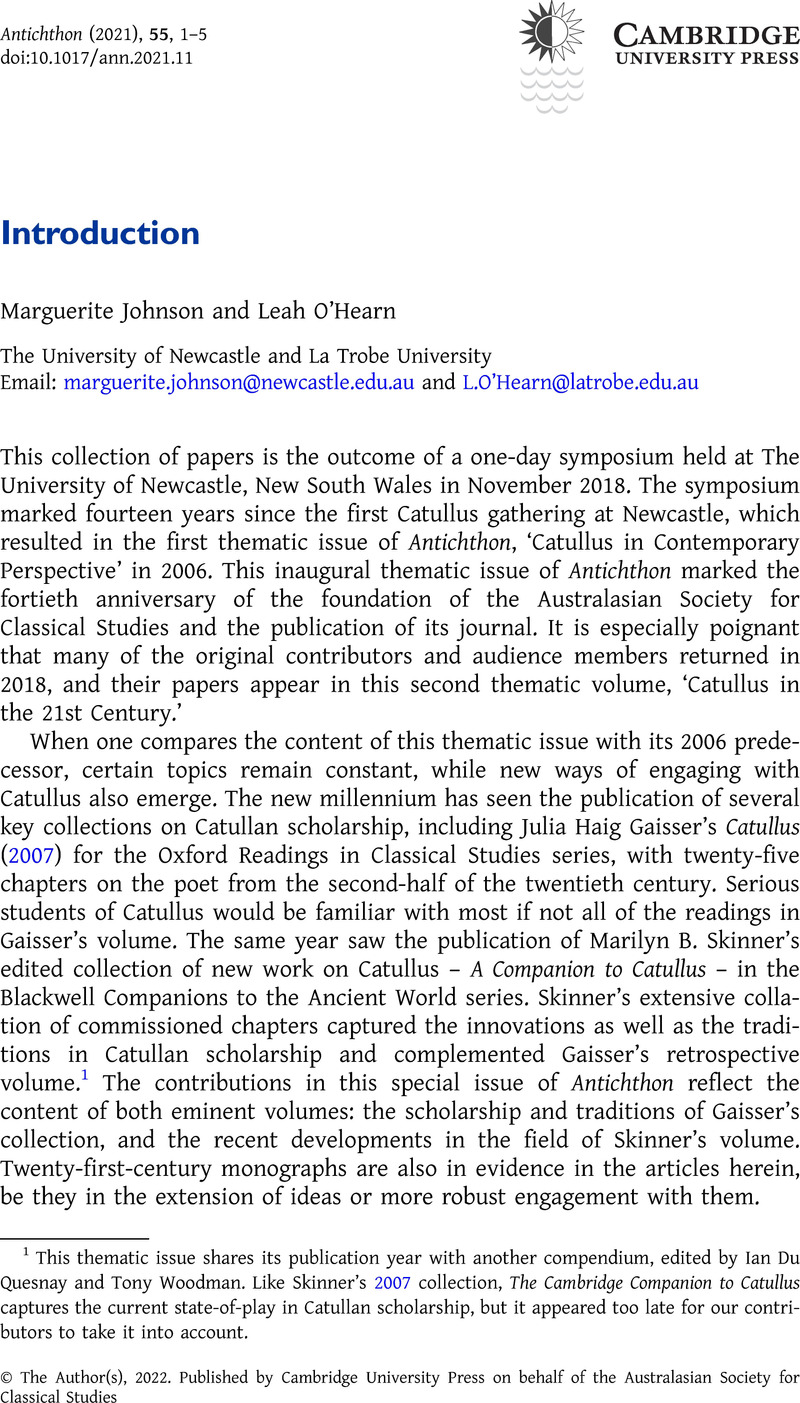No CrossRef data available.
Article contents
Introduction
Published online by Cambridge University Press: 11 February 2022
Abstract
An abstract is not available for this content so a preview has been provided. Please use the Get access link above for information on how to access this content.

- Type
- Introduction
- Information
- Copyright
- Copyright © The Author(s), 2022. Published by Cambridge University Press on behalf of the Australasian Society for Classical Studies
References
Copley, F. O. (1949), ‘Emotional Conflict and its Significance in the Lesbia-poems of Catullus’, AJPh 70, 22–40.Google Scholar
Deuling, J. (2006), ‘Catullus 17 and 67, and the Catullan Construct’, Antichthon 40, 1–9.CrossRefGoogle Scholar
Du Quesnay, I. and Woodman, T. (eds.) (2021), The Cambridge Companion to Catullus. Cambridge.CrossRefGoogle Scholar
Fredricksmeyer, E. A. (1983), ‘The Beginning and the End of Catullus’ longus amor’, SO 58, 63–88.CrossRefGoogle Scholar
Greene, E. (2006), ‘Catullus, Caesar and Roman Masculine Identity’, Antichthon 40, 49–64.CrossRefGoogle Scholar
Hexter, R. J. (2015). ‘The Kisses of Juventius, and Policing the Boundaries of Masculinity’, in Ingleheart, J. (ed.), Ancient Rome and the Construction of Modern Homosexual Identities. Oxford, 273–87.CrossRefGoogle Scholar
Hillard, T. W. (1989), ‘Republican Politics, Women and the Evidence’, Helios 16, 165–82.Google Scholar
Janan, M. (1994), “When the Lamp is Shattered”: Desire and Narrative in Catullus. Carbondale.Google Scholar
O'Hearn, L. (2021), ‘Being Beatus in Catullus’ Poems 9, 10, 22 and 23’, CQ 70, 691–706.CrossRefGoogle Scholar
Oliensis, E. (2009), Freud's Rome: Psychoanalysis and Latin Poetry. Cambridge.CrossRefGoogle Scholar
Rankin, H. D. (1976), ‘Catullus and the ‘Beauty’ of Lesbia (Poems 43, 86 and 51),’ Latomus 35, 3–11.Google Scholar
Skinner, M. B. (1997), ‘Ego mulier: The Construction of Male Sexuality in Catullus’, in Hallett, J. and Skinner, M. B. (eds.), Roman Sexualities. New Jersey, 129–50.Google Scholar
Skinner, M. B. (1979), ‘Parasites and Strange Bedfellows: A Study in Catullus’ Political Imagery’, Ramus 8, 137–52.CrossRefGoogle Scholar
Stead, H. (2015), A Cockney Catullus: The Reception of Catullus in Romantic Britain, 1795–1821. Oxford.CrossRefGoogle Scholar
Watson, L. (2006), ‘Catullus and the Poetics of Incest’, Antichthon 40, 35–48.CrossRefGoogle Scholar
Watson, L. (2009), ‘Catullus and the Brothel-Creepers: Carmen 37’, Antichthon 43, 123–36.CrossRefGoogle Scholar
Uden, J. (2006), ‘Embracing the Young Man in Love: Catullus 75 and the Comic Adulescens’, Antichthon 40, 19–34.CrossRefGoogle Scholar




